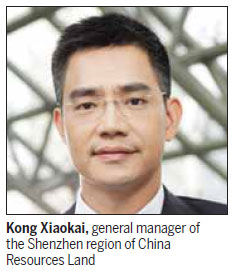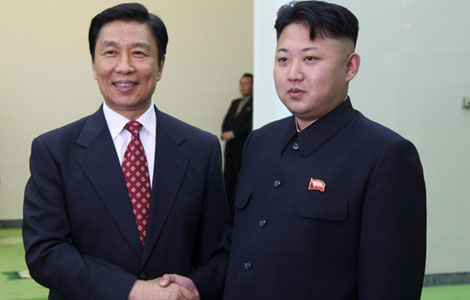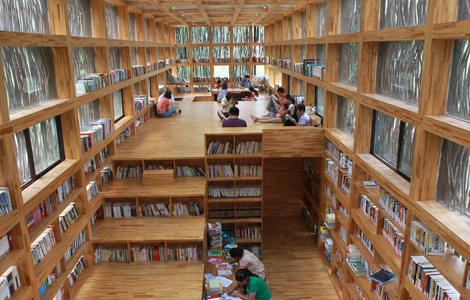
|
City Crossing, backed by the conglomerate China Resources (Holdings) Co, mixes commercial and residential real estate. Provided to China Daily |

City Crossing gives new meaning to commercial realty in Shenzhen
Looking at the new urban complex that is poised to redefine the Shenzhen skyline, it is hard to imagine that it stands on what was once flower and bird markets.
Situated in the central business district, Shenzhen City Crossing is a huge metropolis complex, comprising integrated retail, catering, office, hotel and residential facilities.
"The first phase of the project started in 2000 and it took more than two years to clear out the existing tenants and the half-finished buildings completely," says Kong Xiaokai, general manager of the Shenzhen region of China Resources Land, the developer of the project.
Though there were no major problems associated with the resettlement process, the road ahead was still not smooth for the developer, despite the backing of the Hong Kong-based conglomerate China Resources (Holdings) Co.
Located in Luohu district, Shenzhen, City Crossing has attracted investment of over 6 billion yuan so far and is spread over an area of 100,000 square meters.
The first-phase of the project, including the Mixc (first stage), an 188,000 square meter indoor shopping mall and the 42,000 square meter China Resources Building, a high-end office building, were both opened on December 9, 2004.
The second-phase of the project, with a total floor area of more than 30,000 square meters, was finished in November 2009 and includes among other things the five-star Grand Hyatt Shenzhen hotel, and an expensive housing complex called Park Lane Manor.
The idea of an urban complex was not something that the developer had envisaged at first, and Kong says there was a lot of mix and match before the current model was arrived at.
"When we got the land in 2000, it was supposed to be made up of apartments and an exhibition center," Kong says. "After two years of research, we decided to build an urban complex so that we could use the land more effectively.
"Emboldened by the success of Pacific Place in Hong Kong and also gauging Shenzhen's long-term potential as a commercial center, we decided on a complex featuring and housing different businesses in the heart of the city.
"One year prior to the opening of the Mixc, we realized that we just had one big client - Reel, a family department store. We realized the difficulty for a new player to persuade and attract more big names. We began to promote the shopping mall more aggressively from the end of 2003 onwards."
After approaching several big brands, they convinced Hugo Boss, Zegna and Dunhill to set up shop.
After the opening of the mall, more international brands started showing interest, he says.
Today, luxury brands such as Louis Vuitton, Gucci, Hermes, Prada, Dior, Fendi, Cartier and Bulgari have space in the mall. The first Miu Miu store in the Chinese mainland and the largest Gucci and Prada flagship stores in the Asia-Pacific region are also located in the mall.
"We had to keep on taking in new tenants initially. Some companies moved out after their lease period expired. All of that has changed and most of the big brands who were not interested in us before are now coming to us," Kong says.
Though rentals have gone up, Kong says they have kept pace with the shopping mall's turnover. He adds that during the past few years, the compound growth rate of the mall has been around 20 to 30 percent year-on-year in terms of turnover.
"The increase slowed to 10 percent in 2012, and also for the first half of this year," he says.
He explains that the slowdown is partly because the mall has gone through a rapid expansion period, and also because more competitors are cropping up in the area.
"There is not enough space for us to further develop the potential of the Mixc. We are targeting maintaining the mall's market position and steady growth currently," Kong says.
Besides the complex in Luohu district, the developer is duplicating the business model in 14 other cities, including Hangzhou, Chengdu and Shenyang, in China.
"The Mixc is always located in the center of a city as it is always positioned as a high-end mall," he says.
Right now, the developer is building a higher-end urban complex in Nanshan district, in the southwest of Shenzhen.
"We are differentiating our business model according to different areas. Since west Shenzhen needs premium commercial property, we will upgrade the Mixc there to fill in the gap," he says.
Although Shenzhen Resources Land Ltd has attracted many big brands, it is not focused on bringing the current luxury brands to all of its projects.
"We are building nearly 20 Dreamports, a shopping mall targeting massive ordinary consumers," he says.
Kong adds that although there is a strong demand for urban complexes in China, it is important to choose the correct location and be creative in management to stay profitable.
Contact the writers through yaojing@chinadailly.com.cn
(China Daily Africa Weekly 07/26/2013 page15)








